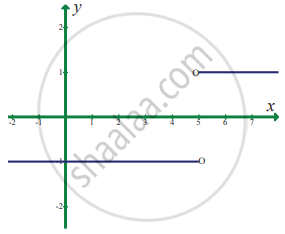Advertisements
Advertisements
प्रश्न
Evaluate the following limits:
`lim_(x -> oo) ((2x^2 + 3)/(2x^2 + 5))^(8x^2 + 3)`
उत्तर
`lim_(x -> oo) ((2x^2 + 3)/(2x^2 + 5))^(8x^2 + 3) = lim_(x -> oo)((2x^2 + 5 - 2)/(2x^2 + 5))^(8x^2 + 20 - 17)`
= `lim_(x -> oo) ((2x^2 - 5)/(2x^2 + 5) - 2/(2x^2 + 5))^(4(2x^2 + 5) - 17)`
= `lim_(x -> 00) (1 - 2/(2x^2 + 5))^(4(2x^2 + 5) - 17)`
Put 2x2 + 5 = y
When x → ∞
We have y = 2 × ∞ + 5 = ∞
x → ∞
⇒ y → ∞
∴ `lim_(x -> oo) ((2x^2 + 3)/(2x^2 + 5))^(8x^2 + 3) = lim_(y -> oo) (1 - 2/y)^(4y - 17)`
= `lim_(y - oo) (1 - 2/y)^(4y) xx (1 - 2/y)^(-17)`
= `lim_(y ->oo) (1 -2/y)^(4y) xx lim_(y -> oo) (1 - 2/y)^(- 17)`
= `(lim_(y -> oo) (1 - 2/y)^y)^4 xx (1 - 2/oo)^(- 17)` ........(1)
We know `lim_(x -> oo) (1 + "k/x)^x` = ek
(1) ⇒ `lim_(x -> oo) ((2x^2 + 3)/(2x^2 + 5))^(8x^2 + 3)`
= `(lim_(y -> oo)(1 + ((-2))/y)^y)^4 xx (1 - 0)^(- 17)`
= `("e"^(-2))^4 xx 1`
= `"e"^(-8)`
= `1/"e"^8`
APPEARS IN
संबंधित प्रश्न
Evaluate the following limit :
`lim_(x -> 1)[(x + x^2 + x^3 + ......... + x^"n" - "n")/(x - 1)]`
In the following example, given ∈ > 0, find a δ > 0 such that whenever, |x – a| < δ, we must have |f(x) – l| < ∈.
`lim_(x -> -3) (3x + 2)` = – 7
In problems 1 – 6, using the table estimate the value of the limit.
`lim_(x -> 2) (x - 2)/(x^2 - x - 2)`
| x | 1.9 | 1.99 | 1.999 | 2.001 | 2.01 | 2.1 |
| f(x) | 0.344820 | 0.33444 | 0.33344 | 0.333222 | 0.33222 | 0.332258 |
In problems 1 – 6, using the table estimate the value of the limit
`lim_(x -> - 3) (sqrt(1 - x) - 2)/(x + 3)`
| x | – 3.1 | – 3.01 | – 3.00 | – 2.999 | – 2.99 | – 2.9 |
| f(x) | – 0.24845 | – 0.24984 | – 0.24998 | – 0.25001 | – 0.25015 | – 0.25158 |
In exercise problems 7 – 15, use the graph to find the limits (if it exists). If the limit does not exist, explain why?
`lim_(x -> 5) |x - 5|/(x - 5)`
Evaluate the following limits:
`lim_(x ->) (x^"m" - 1)/(x^"n" - 1)`, m and n are integers
Evaluate the following limits:
`lim_(sqrt(x) -> 3) (x^2 - 81)/(sqrt(x) - 3)`
Evaluate the following limits:
`lim_(x -> 5) (sqrt(x + 4) - 3)/(x - 5)`
Evaluate the following limits:
`lim_(x -> 2) (1/x - 1/2)/(x - 2)`
Evaluate the following limits:
`lim_(x - 0) (sqrt(1 + x^2) - 1)/x`
Evaluate the following limits:
`lim_(x -> 5) (sqrt(x - 1) - 2)/(x - 5)`
Evaluate the following limits:
`lim_(x -> oo)(1 + "k"/x)^("m"/x)`
Evaluate the following limits:
`lim_(x -> 0) (sqrt(1 + sinx) - sqrt(1 - sinx))/tanx`
Evaluate the following limits:
`lim_(x -> ) (sinx(1 - cosx))/x^3`
Choose the correct alternative:
`lim_(x -> 0) sqrt(1 - cos 2x)/x`
Choose the correct alternative:
`lim_(x -> 0) ("a"^x - "b"^x)/x` =
Choose the correct alternative:
`lim_(x -> 3) [x]` =
Choose the correct alternative:
The value of `lim_(x -> 0) sinx/sqrt(x^2)` is
`lim_(x→∞)((x + 7)/(x + 2))^(x + 4)` is ______.
